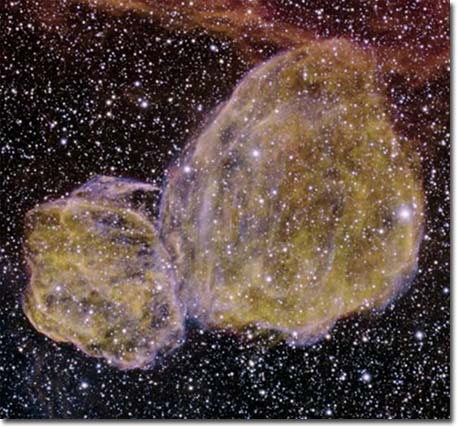The graceful dance of a meteorite ruin
The GMini (Gemini South Multi-Object Spectograph) tool recently captured a strange image of a wide cloud called DEM L 316 in the Magellanic Large Cloud area. The peanut-shaped nebula appears to be a simple form, but recent work indicates that the nebula is actually made up of two separate clouds that carry gas and dust that they are made of. Various explosions of meteor.
The latest image clearly shows intertwined ' spiral shapes ' of gas and dust in the exploding stars that have created an expanding cloud. The object was first identified in the early 1970s as the remnant of a new star, the cloud enriched by the material created at the explosion of another star. But that nebula must have been formed thousands of years ago because many types of meteorites exploded right in the Magellanic Large Cloud.
"The remarkable and clear observations of GMOS have shown the structure of a complex collision," said Dr. Rosa Williams of the National University of Columbus . This is a big step to understand the pair of mesmerizing nebulae, which are the remnants of the big star. They can be a random pair in the sky, or there is a connection between them, which is waiting to be discovered. '
Other observations just recently on the Chandra DEM L316 and XMM-Newton X-ray reinforce the idea that the cloud is indeed a remnant made up of two meteor stars lined up randomly on The sky and not one single thing remain with the bipolar shape bent. These observations reveal the chemical composition of two different shells, which are created by different explosions. The data obtained show that the smaller ruins (lower left corner of the image) contain mostly iron. The abundance of iron in the small nebula shows that gas is the product of a meteor, accompanied by a white dwarf near it. Because those white dwarfs are too ancient objects, the system has to go through several billion years before the explosion comes.

Trace of meteor - DEM L316 (Photo: Techno-science)
In contrast, the larger nebula is less iron than the result of Type II meteor, which works by the collapse of a massive star (7 times the mass of the Sun) when that star old for several million years. The two original systems are oddly different in age when they become meteor, they may not originate from the same system. So, although its detailed construction is seen in the GMOS image, it shows that the two nebulae are touching each other ' face ', seemingly very close together in the sky, probably because they line up in ' the ' Look at ours.
The great Magellanic cloud (LMC) is a galaxy in our Milky Way, about 160,000 light-years away in the direction of the star cluster Dorade. The DEM Nebula L316 is located in LMC and the two nebulae stretch over a distance of nearly 140 light-years (an approximate 35 times the distance between the Sun and the nearest star).
- The decipherment of the 'space death' caused the Earth to fall into ruin: Scientists crazy!
- He has a dance signaling death
- Men dancing also revealed gender capabilities
- The sexy tap-dance of the blue bird
- Find the largest meteorite pieces in Russia
- Flocking to find meteorite fragments in Russia
- The meteorite explosions
- Video: The choking moment jumps from a height of 7.6 km without parachutes
- A meteorite as big as the Great Pyramid is about to fly over the Earth
- What is Chondrit meteorite?
- The oldest meteorite is about the same age as the Solar System
- Strange meteorite split itself
 Van Allen's belt and evidence that the Apollo 11 mission to the Moon was myth
Van Allen's belt and evidence that the Apollo 11 mission to the Moon was myth The levels of civilization in the universe (Kardashev scale)
The levels of civilization in the universe (Kardashev scale) Today Mars, the sun and the Earth are aligned
Today Mars, the sun and the Earth are aligned The Amazon owner announced a secret plan to build a space base for thousands of people
The Amazon owner announced a secret plan to build a space base for thousands of people